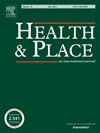The associations of real-time and perceived air pollution exposure with episode-level subjective wellbeing: a case study of a suburban community in Beijing
IF 4.1
2区 医学
Q1 PUBLIC, ENVIRONMENTAL & OCCUPATIONAL HEALTH
引用次数: 0
Abstract
Background
The dynamics of everyday life and mobility patterns are often neglected in studies examining the association between air pollution and subjective wellbeing (SWB). We investigated the association between air pollution exposure, both by ambient and perceived measurement, and subjective wellbeing for individuals’ activity episodes and trips in Beijing.
Methods
Data on 1688 activities and 573 trips were obtained from the activity-travel diary survey in the Meiheyuan residential community, Beijing, from November 2017 to January 2018. Real-time exposure to ambient air pollution (AAP) in the form of fine particulate matter (PM2.5) was collected using portable air pollution sensors, and perceived air pollution (PAP) and SWB at the episode level were acquired through activity-travel diaries. Multi-level structural equation modelling (ML-SEM) was used to investigate the associations between air pollution and SWB separately for daily activity episodes and trips.
Results
PAP is not only directly associated with SWB at both activity and trip episodes but also mediates between AAP and SWB for activities. A time-lagged effect of AAP on SWB is observed for trips, where AAP of the preceding episode is directly linked to SWB at the current episode. Location plays a fundamental role in shaping individuals’ AAP, PAP and SWB at activity episodes. The effects of start time, location, activity type and duration are primarily mediated by location and location-PAP. life circumstances shape their exposure to and perceptions of air pollution, as well as their SWB during activity and trip episodes.
Conclusion
People's perception of air pollution bears a more pronounced relationship with their satisfaction with individual activities and trips compared to the objective measurements of ambient PM2.5 exposure. It also highlights that ambient PM2.5 exposure during the preceding activity episode has a time-lagged effect on satisfaction with the current trip episode.
实时和感知空气污染暴露与事件级主观幸福感的关系:北京郊区社区的案例研究
在研究空气污染与主观幸福感(SWB)之间关系的研究中,日常生活和移动模式的动态常常被忽视。我们调查了空气污染暴露(通过环境测量和感知测量)与个人在北京活动和旅行的主观幸福感之间的关系。方法通过2017年11月至2018年1月在北京市梅河源居民社区开展的活动-旅行日记调查,获取1688次活动和573次旅行数据。使用便携式空气污染传感器收集细颗粒物(PM2.5)形式的实时环境空气污染暴露(AAP),并通过活动-旅行日记获取事件水平的感知空气污染(PAP)和SWB。采用多层结构方程模型(ML-SEM)分别研究了空气污染与日常活动次数和出行次数之间的关系。结果spap不仅与活动和旅行时的主观幸福感直接相关,而且在活动时的AAP和主观幸福感之间起中介作用。在旅行中观察到AAP对SWB的时滞效应,其中前一集的AAP与当前一集的SWB直接相关。地理位置对个体活动时的AAP、PAP和SWB具有重要影响。开始时间、地点、活动类型和持续时间的影响主要由地点和地点- pap介导。生活环境塑造了他们对空气污染的暴露和感知,以及他们在活动和旅行期间的主观幸福感。结论与PM2.5暴露的客观测量值相比,人们对空气污染的感知与他们对个人活动和旅行的满意度之间的关系更为明显。研究还强调,前一活动阶段的环境PM2.5暴露对当前旅行阶段的满意度具有时间滞后效应。
本文章由计算机程序翻译,如有差异,请以英文原文为准。
求助全文
约1分钟内获得全文
求助全文
来源期刊

Health & Place
PUBLIC, ENVIRONMENTAL & OCCUPATIONAL HEALTH-
CiteScore
7.70
自引率
6.20%
发文量
176
审稿时长
29 days
期刊介绍:
he journal is an interdisciplinary journal dedicated to the study of all aspects of health and health care in which place or location matters.
 求助内容:
求助内容: 应助结果提醒方式:
应助结果提醒方式:


